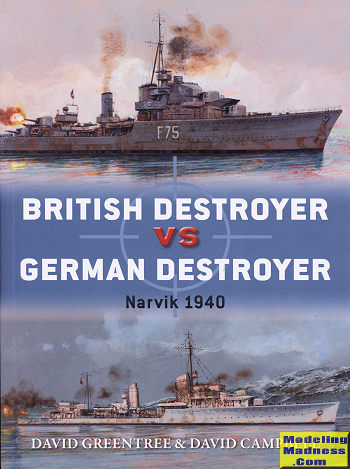 This
latest matchup in Osprey's popular Duel series concentrates on two adversaries
that met each other in the icy waters of the fjords of Narvik in Norway during
1940. This was a somewhat unexpected meeting of fleets in general and destroyers
in particular. Narvik was vitally important to Germany as that is where the
majority of iron ore from Sweden was collected to be shipped to Germany. The
British wanted to stop the shipment of this ore, knowing how important it was to
the German war effort. They felt the Norwegians would be unwilling or unable to
prevent the shipments from happening. At the time, Norway was neutral so was not
in a position to bow to British demands.
This
latest matchup in Osprey's popular Duel series concentrates on two adversaries
that met each other in the icy waters of the fjords of Narvik in Norway during
1940. This was a somewhat unexpected meeting of fleets in general and destroyers
in particular. Narvik was vitally important to Germany as that is where the
majority of iron ore from Sweden was collected to be shipped to Germany. The
British wanted to stop the shipment of this ore, knowing how important it was to
the German war effort. They felt the Norwegians would be unwilling or unable to
prevent the shipments from happening. At the time, Norway was neutral so was not
in a position to bow to British demands.
The Germans felt that this port would be in danger so
that was one of the main reasons they invaded Norway in 1940. To carry troops to
Narvik, they used destroyers. The British were in the process of mining the
entrance and due as much to the horrid weather that time of year, were unaware
that the Germans had successfully landed troops. The British also had a group of
destroyers in the area in preparations for their own invasion of Narvik to keep
it from German occupation.
To make a really long story short, the British caught
most of the German destroyers in port refueling or standing by to do so. The
ensuing battles were a mixture of luck, poor operational planning and weather
factors. Both sides took a drubbing, but it was the Germans who ended up on the
short end of the stick.
Germany did not have the fleet that the British had.
Their destroyers were more powerful in terms of armament, but they were also
larger, a bit top heavy, and not good in open or rough seas. They were designed
for the Baltic, not the North Sea. The British, on the other hand, had a huge
navy to take care of all its overseas territories. Their destroyers were
smaller, but were excellent sea-keepers. Both sides had motivated crews and in
terms of training, were probably fairly equal.
In addition to full descriptions of the technical aspect
of the ships of both sides, this is as much a story of the 1940 Narvik battle as
it is anything else. It is a battle that had important results for both sides.
It provided a real problem for the British, who eventually captured the town,
but were unable to hold it, keeping Narvik in German hands until the end of the
war and providing nautical targets for British bombers as they tried to slow
down ore shipments for the next five years. A great read and one that I found to
be quite interesting as I knew little more than just the basics of this event.
November 2018
Copyright ModelingMadness.com. All rights reserved.
For more on the complete line of Osprey books,
visit www.ospreypublishing.com .
If you would like your product reviewed fairly and quickly, please
contact
me or see other details in the
Note to
Contributors.
 This
latest matchup in Osprey's popular Duel series concentrates on two adversaries
that met each other in the icy waters of the fjords of Narvik in Norway during
1940. This was a somewhat unexpected meeting of fleets in general and destroyers
in particular. Narvik was vitally important to Germany as that is where the
majority of iron ore from Sweden was collected to be shipped to Germany. The
British wanted to stop the shipment of this ore, knowing how important it was to
the German war effort. They felt the Norwegians would be unwilling or unable to
prevent the shipments from happening. At the time, Norway was neutral so was not
in a position to bow to British demands.
This
latest matchup in Osprey's popular Duel series concentrates on two adversaries
that met each other in the icy waters of the fjords of Narvik in Norway during
1940. This was a somewhat unexpected meeting of fleets in general and destroyers
in particular. Narvik was vitally important to Germany as that is where the
majority of iron ore from Sweden was collected to be shipped to Germany. The
British wanted to stop the shipment of this ore, knowing how important it was to
the German war effort. They felt the Norwegians would be unwilling or unable to
prevent the shipments from happening. At the time, Norway was neutral so was not
in a position to bow to British demands.